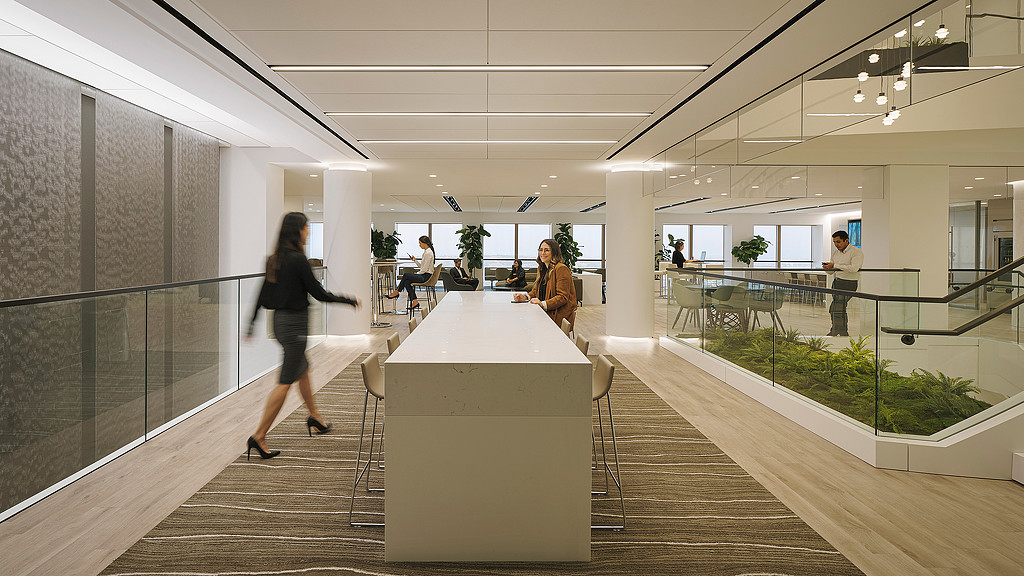Reset: The Future Law Firm Workplace
April 16, 2021 | By Barbara Dunn
Even before COVID-19, law firms were rethinking their corporate footprint by focusing on shedding space, increasing efficiency, and shifting the balance of shared and individual spaces. With real estate being one of the highest firm costs after salaries, law firms that have relocated within the last few years have, on average, reduced their office space by up to 30% and law firms renewing their leases have reduced their workspace by 15% or more.
Post-pandemic, the trend to downsize will likely prevail in the legal industry. McKinsey Research expects the percentage of time worked in main offices to decline by 12% and some real estate professionals predict a 15 to 25% reduction in space occupied by law firms. As the hybrid work model is increasingly embraced, it seems apparent that law firm employees will continue to work from home for part of the work week, and firms will implement hoteling strategies to maximize density and accommodate growth. Target ratios, once over 700 square feet per attorney could be down as low as 400 to 500 square feet per attorney. (And who doesn’t want to realize a reduction in rent?)
But what is the real cost of an increase in remote work?Before the pandemic, an attractive, comfortable, and innovative work environment was deemed critical to productivity, culture, and winning talent. But the legal world was already starting to experience an issue with fostering a strong firm culture pre-pandemic. Occupancy studies show that private attorney offices are empty for 40% of the workday — senior attorneys were particularly in the habit of not coming into the office every day.
The recent work-from-home experience has proven that attorneys can do without big private offices, lots of paper and files, and underutilized space. Now is the chance to reset the law office. When we do return, how will the purpose of the legal office evolve to deliver a connected, holistic work experience for everyone, from partners to young associates? The Gensler Research Institute’s recent survey found that the legal workplace offers benefits that young associates say will continue to attract them to come into the office, including mentorship, team connection, access to coaching and feedback, developing mastery, and engaging with peers. And although younger attorneys were already asking for a more flexible work policy before COVID-19, they now face the challenge of finding quality mentorship remotely.
Smart law firms are looking to incorporate a hybrid work model that embraces mobility, increases amenities, and delivers a great workplace experience for a multigenerational workforce.
As the office gets more social, workplace design will support new types of space.To encourage culture and connection, firms need to blur the lines. As ‘home as office’ becomes more normalized, many firms will want a progressive, non-traditional aesthetic in their legal workplaces to promote more comfort and embrace a hybrid way of working. A modern law firm office that incorporates residential comfort and hospitality-design elements also provides greater opportunities for casual interaction, networking, cross-selling, and building trust among colleagues.
As we continue with a hybrid model, combining remote and in-the-office work, legal firms will need to develop planned activities and programs that connect people and build culture and comradery, supported by the right types of spaces, amenities, and new technologies.
Design elements like an interconnecting stair to link people, lounges, terraces, and cafés for attorneys and staff to socialize, complete with amenities such as a genius bar, coffee, and snacks, will continue to play an important role in providing an office that attracts the best talent and encourages a culture of engagement. Incorporating features that remote work can’t offer gives attorneys a reason to come to the office and draws them back together.
As the primary purpose of the workspace shifts to accommodate more collaboration, mentoring, and knowledge-sharing (rather than individual work), collaboration and meeting spaces will likely increase proportionally in the office. In the future, people will come to the office intentionally to meet face-to-face. Attorneys can do heads-down work in small focus rooms or even at home, but it’s critical that the legal workplace of the future support the kinds of interactions and collaborations that do not work well remotely.
Going forward, mobility, flexibility, and efficiency are top of mind.Now that lawyers have successfully been able to work from anywhere, mobility is here to stay and should be factored into law firms’ corporate real estate strategies. For example, Freshfields announced in August they are implementing an “office release system,” which allows someone to use your office if you are working remotely. If you need to be in the office, you simply ‘book’ an office, like a conference room. This newly adopted system resulted in a 20% space savings.
Top global law firms are also exploring hoteling options and those with leases that are due for renewal are rethinking their occupancy strategy. Law firms that were planning pre-pandemic to lease extra space to support planned growth, are now reducing the amount of attorney offices, implementing a universal-sized attorney office, and adding interior offices for associates. As work from home and hoteling are embraced as more permanent solutions to managing growth, law firms will need to establish formal policies and protocols to support all modes of working, including a clean desk policy and implementing a space reservation system.
Contrary to what many might expect, Gensler’s Work From Home 2020 Survey found just 12%, or roughly one in eight, U.S. legal workers wants to work from home full-time after the pandemic. Likewise, a recent poll of one region of ALA members confirms a hybrid option will most likely be the future — nearly 88% of respondents overwhelmingly indicated they were not considering a 100% virtual environment for the future. Instead, the legal office must adapt to support new workers expectations and behaviors.
Technology is the driver of change.With the crucial need for workers to be connected all the time, firms are allocating more financial resources to technology. With an expected increased need for secured networks and more video and broadband service, new office buildouts will include multiple small rooms, for example, that are designed to support to video conferencing with remote participants.
The pandemic has also accelerated the focus on health and wellness in the workplace.To promote well-being, the future legal office will also prioritize good air quality, access to outdoor space, and biophilic design elements like green walls and plants in interior design.
To address the mounting concern of infectious diseases transmission by touching contaminated surfaces, the office environment will incorporate more hands-free elements with individuals’ smart phones able to grant security access, turn on lights, and order a cup of coffee.
The great takeaway from the work-from-home experiment is the power of choice.Gensler’s research on the legal workplace shows a clear distinction between what works for partners and what works for associates. According to survey findings, experienced partners can handle a high degree of remote working, but it is much harder to learn how to do your job from home and younger attorneys are less likely to feel a sense of accomplishment and are less aware of what is expected of them. Going forward, senior partners will need to be in the office at least part of the week to provide critical mentorship to younger lawyers.
As the boundaries been work and home are increasingly blurred, new challenges arise including the need to create distance between work and non-work activities.
Providing people with greater choice in where and when they can do their best work can lead to better balance and overall personal satisfaction. As mobility and virtual collaboration increase, face-to-face interactions become more meaningful, and the physical workplace simply outperforms video conferencing at fostering the connections that law firm partnerships need to thrive.
By embracing hybrid ways of working, legal industry leaders can use this time of uncertainty and experimentation to research and understand individual attorney and staff needs, define new ways of promoting firm culture, and test new ideas for an optimized return to the reimagined legal workplace.
For media inquiries, email .

